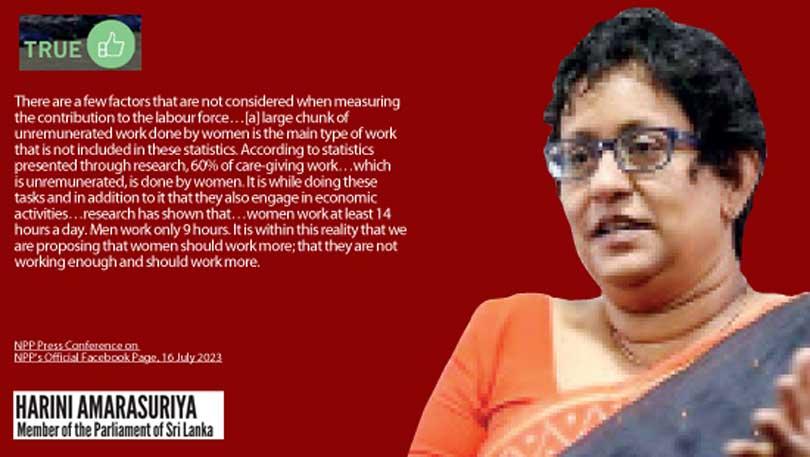17 Aug 2023 - {{hitsCtrl.values.hits}}

 The MP made three claims regarding low female labour force participation in Sri Lanka: (1) official statistics on contribution to the labour force underestimate women’s contribution to work by not taking account of unpaid work; (2) 60% of unpaid, caregiving work is done by women, and (3) women already work more hours in a day (14 hours) than men (9 hours).
The MP made three claims regarding low female labour force participation in Sri Lanka: (1) official statistics on contribution to the labour force underestimate women’s contribution to work by not taking account of unpaid work; (2) 60% of unpaid, caregiving work is done by women, and (3) women already work more hours in a day (14 hours) than men (9 hours).
To evaluate these claims, FactCheck.lk analysed the latest available data for the Labour Force Survey (LFS) 2021, Sri Lanka Time Use Survey (SLTUS) 2017 by the Department of Census and Statistics and the book titled Working Hours: Exploring Gender Dimensions of Unpaid Care Work in Sri Lanka by the Women and Media Collective (WMC).
Claim 1: The official reporting of Sri Lanka’s economically active population (labour force) lists two main categories, the employed and the unemployed (those seeking but not able to find employment). The employed are counted in four groups: employees, employers, own account workers, and unpaid family workers. Those within the labour force engage in (or are attempting to engage in) producing goods and services for market sale or exchange. This kind of ‘work’ is counted within the System of National Accounts (SNA) framework—known as SNA activities. Therefore, when assessing the contribution to the labour force, time spent in non-SNA activities (inclusive of unpaid housework, care work, and voluntary activities) is not accounted for. By omitting non-SNA work in official labour statistics, the MP’s claim is substantiated.
Claim 2: The 2017 SLTUS, a national survey, records time spent in unpaid work at 5.7 hours for women and 1.6 hours for men. However, another survey conducted by the WMC covering six districts in Sri Lanka (40% of the population), shows the corrected population time spent on average per day on all unpaid housework, care, and voluntary activities as 9.14 hours for women and 5.96 hours for men. These numbers can be used to derive that women contribute to 60% of unpaid care work (9.14/15.1). The MP, therefore, seems to be using the statistics of the WMC survey to compute the 60%. The SLTUS statistics support the MP’s case even more with a much higher percentage of 81% in terms of women’s contribution to unpaid care work.
Claim 3: The MP’s claim suggests a reference to the total work hours of men and women. Data on total work from SLTUS shows time spent on paid and unpaid work by women and men as 7.9 and 7.3 hours. These figures support the MP’s overall claim that women work more hours in a day than men. However, the MP cites figures, sourced from the WMC, that pertain solely to unpaid care work (13.77 hours for women, 8.98 hours for men), which is an intermediate uncorrected statistic, the finalised corrected statistic was cited in analysing claim 2 (9.14 hours for women, 5.96 hours for men).
Although one set of numbers the MP cited for total work (14 and 9 hours a day) seems to be based on a misunderstanding all the available data supports the MP’s three claims and her larger argument. That is, women are already working more hours a day than men and are also doing a larger share of the unpaid care work, despite women being evaluated as contributing less to the labour force—due to the limitations in how labour force contribution is measured.
Therefore, we classify her statement as TRUE.
FactCheck is a platform run by Verité Research.
For comments, suggestions and feedback, please visit www.factcheck.lk.
27 Apr 2024 5 hours ago
27 Apr 2024 7 hours ago
27 Apr 2024 8 hours ago
27 Apr 2024 27 Apr 2024
27 Apr 2024 27 Apr 2024